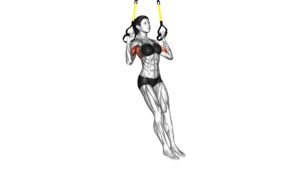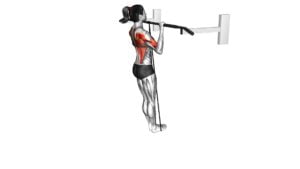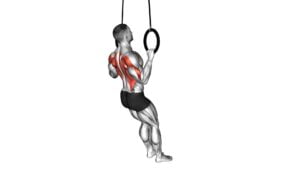Assisted Pull-up (female) – Video Exercise Guide & Tips

Are you a female looking to improve your upper body strength? Get ready to conquer the pull-up with our assisted pull-up exercises!
Watch This Exercise Video
In this video exercise guide, we'll show you the benefits of assisted pull-ups, how to choose the right resistance band or machine, and proper form and technique.
Plus, we'll give you progression tips to work towards unassisted pull-ups and common mistakes to avoid.
Get ready to strengthen and tone your upper body like never before!
Key Takeaways
- Assisted pull-ups help build upper body strength, developing back, shoulder, and arm muscles.
- Resistance bands or machines with adjustable weight stack are preferred for choosing the right assistance.
- Proper form and technique are important, including maintaining a firm grip, utilizing assistance, and using a neutral grip.
- Gradually decreasing assistance, focusing on progressive resistance training, and incorporating core exercises are key for progression and building strength.
Benefits of Assisted Pull-ups for Females
There are several benefits of assisted pull-ups for females. Incorporating resistance band modifications into your pull-up routine can help you achieve these benefits more effectively.
One of the primary benefits of assisted pull-ups is that they help build upper body strength. By using resistance bands, you can gradually increase the resistance as you get stronger, allowing you to progress at your own pace. This is particularly beneficial for females, as it can help develop the muscles in the back, shoulders, and arms, which are often overlooked in traditional workout routines.
Another advantage of assisted pull-ups is that they improve grip strength. As you pull yourself up, you engage the muscles in your hands and forearms, which can enhance your overall grip strength. This can be especially useful in various daily activities, such as carrying groceries or lifting heavy objects.
Assisted pull-ups also help improve posture and core stability. By engaging the core muscles during the movement, you can strengthen your abdominal and lower back muscles, which in turn can help improve your posture and stability in other exercises and activities.
Choosing the Right Resistance Band or Machine
To choose the right resistance band or machine for assisted pull-ups, consider your current fitness level and the amount of assistance you need. Choosing the right equipment is crucial to ensure that you're able to perform assisted pull-ups effectively and safely.
When it comes to resistance bands, there are various options available, each providing different levels of assistance. These bands are color-coded, with each color representing a different level of resistance. If you're a beginner or have limited upper body strength, it's advisable to start with a band that provides more assistance. As you progress and become stronger, you can gradually move on to bands with less assistance.
If you prefer using a machine for assisted pull-ups, make sure to choose one that has an adjustable weight stack or resistance setting. This will allow you to customize the amount of assistance you receive based on your individual needs.
Regardless of whether you choose a resistance band or a machine, it's important to focus on proper technique and form. Keep your core engaged, shoulders down and back, and pull yourself up using your back and arm muscles. Avoid using momentum or relying too heavily on the assistance provided by the equipment.
Proper Form and Technique for Assisted Pull-ups
To perform assisted pull-ups with proper form and technique, it's crucial to focus on your grip and positioning. Make sure to maintain a firm grip on the bar with your palms facing away from you and your hands shoulder-width apart.
Additionally, utilize the assistance provided by the resistance band or machine to support your body weight while still engaging your back and arm muscles.
As you progress, consider gradually decreasing the assistance and modifying the exercise to challenge yourself further.
Grip and Positioning
Use a neutral grip with your palms facing each other to maintain proper form and technique for assisted pull-ups. This grip variation helps to engage your back muscles more effectively and reduces strain on your wrists and shoulders.
Here are three key points to remember when it comes to grip and positioning:
- Keep your hands shoulder-width apart on the bar to ensure a comfortable and stable grip.
- Maintain a straight line from your shoulders to your hips throughout the exercise to promote proper alignment and prevent injuries.
- Avoid relying too much on your arms by engaging your back muscles and squeezing your shoulder blades together as you pull yourself up.
By following these grip and positioning tips, you'll be able to perform assisted pull-ups with better form and technique.
Now, let's move on to the next section, where we'll discuss how to utilize assistance properly for maximum benefit.
Utilizing Assistance Properly
Now that you have established the proper grip and positioning for assisted pull-ups, it's time to focus on utilizing assistance properly to ensure proper form and technique.
When performing assisted pull-ups, there are different assistance variations that you can choose from. Some common options include using resistance bands, an assisted pull-up machine, or having a spotter assist you.
It's important to remember that regardless of the assistance variation you choose, maintaining proper form and technique is crucial. One common misconception is that using assistance means you can sacrifice form and technique. This isn't true. You should still engage your core, keep your shoulders back and down, and pull yourself up using your back muscles.
By utilizing assistance properly and maintaining proper form, you'll build strength and progress towards unassisted pull-ups.
Now let's discuss progression and modifications to help you achieve that goal.
Progression and Modifications
As you progress in your assisted pull-up training, it's important to focus on proper form and technique to maximize your results. Here are some progression techniques and common misconceptions to keep in mind:
- Gradually decrease assistance: As you get stronger, gradually reduce the assistance provided by the resistance band or assistance machine. This will challenge your muscles and help you build strength.
- Maintain proper body alignment: Keep your core engaged, shoulders pulled back, and chest lifted throughout the movement. Avoid swinging or using momentum to complete the exercise. This will ensure that you're targeting the correct muscles and reducing the risk of injury.
- Use a controlled tempo: Slowly lower yourself down and then pull yourself up with control. This will help you build strength and increase your time under tension.
By following these progression techniques and avoiding common misconceptions, you'll be on your way to mastering assisted pull-ups and preparing yourself for unassisted pull-ups.
Now, let's move on to the next section for some progression tips to build strength for unassisted pull-ups.
Progression Tips to Build Strength for Unassisted Pull-ups
To build strength for unassisted pull-ups, focus on progressive resistance training. This method involves gradually increasing the intensity of your workouts over time, allowing your muscles to adapt and grow stronger.
When it comes to building upper body strength for pull-ups, exercises such as lat pulldowns, inverted rows, and assisted pull-ups can be beneficial. These exercises target the muscles used in pull-ups, including the back, shoulders, and arms.
Additionally, building core strength is crucial for performing pull-ups effectively. Incorporating exercises like planks, Russian twists, and hanging leg raises into your routine can help strengthen your core muscles, providing stability and control during the pull-up movement.
As you progress with your resistance training, you can gradually reduce the amount of assistance you use during assisted pull-ups. Start by using a lighter resistance band or decreasing the assistance provided by a spotter. By challenging yourself with less assistance, you'll gradually build the strength required to perform unassisted pull-ups.
Now that you have learned some progression tips to build strength for unassisted pull-ups, let's move on to the next section, where we'll discuss common mistakes to avoid during assisted pull-ups.
Common Mistakes to Avoid During Assisted Pull-ups
To avoid common mistakes during assisted pull-ups, focus on maintaining proper form and technique. By understanding the most common misconceptions and avoiding them, you can effectively perform this exercise while minimizing the risk of injuries.
Here are three key points to keep in mind:
- Avoid relying too heavily on the assistance: One common mistake is relying too much on the assistance provided by the machine or resistance band. Remember, the goal is to gradually build strength and eventually perform unassisted pull-ups. Use the assistance as a support, but still engage your muscles and work on pulling yourself up.
- Don't neglect your core: Many people make the mistake of neglecting their core muscles during assisted pull-ups. It's crucial to engage your core throughout the movement to maintain stability and control. This won't only help you perform the exercise correctly but also prevent any strain or injuries.
- Maintain proper body alignment: Another common mistake is allowing your body to swing or sway during the exercise. This not only reduces the effectiveness of the pull-up but also puts unnecessary stress on your joints. Focus on keeping your body straight and stable throughout the movement, ensuring that your shoulders, hips, and feet are aligned properly.
Sample Assisted Pull-up Workout Routine
To maximize the effectiveness of your assisted pull-up workout routine, consider incorporating resistance band modifications. These bands provide varying levels of assistance, allowing you to gradually increase the challenge as you build strength.
It's crucial to maintain proper form and technique throughout each rep, focusing on engaging your back muscles and avoiding excessive swinging or momentum.
Over time, as you consistently work on your pull-ups, you'll notice an improvement in your strength and ability to perform the exercise without assistance.
Resistance Band Modifications
Start your assisted pull-up workout routine by incorporating resistance band modifications. Resistance bands are a great tool to assist you in building strength and improving your ability to perform pull-ups. Here are three alternative modifications you can try:
- Band Assisted Pull-ups: Attach a resistance band to the pull-up bar and loop it around your foot or knee. This will provide assistance as you pull yourself up, making the exercise more achievable.
- Negative Pull-ups: Start at the top of the pull-up position and slowly lower yourself down, focusing on the eccentric phase of the exercise. The resistance band can be used to provide support and make it easier to control the descent.
- Band Rows: Attach the resistance band to a stable anchor point and hold the ends in your hands. Step back to create tension and perform rows by pulling the band towards your chest.
By incorporating these resistance band exercises into your routine, you can gradually build strength and work towards performing unassisted pull-ups.
Now, let's move on to the next section, where we'll discuss proper form and technique.
Proper Form and Technique
Continue incorporating resistance band modifications to your assisted pull-up workout routine by focusing on proper form and technique.
Proper form is crucial for maximizing the effectiveness of your workout and preventing injuries. One common mistake is using too much momentum to complete the exercise instead of relying on your muscles.
To maintain proper form, start by gripping the bar with your palms facing away from you and your hands slightly wider than shoulder-width apart. Keep your core engaged and your shoulders pulled down and back. As you pull yourself up, focus on using your back muscles and avoid swinging or kicking your legs.
Here is a sample workout to help you practice proper form: perform 3 sets of 8-12 assisted pull-ups, resting for 60 seconds between sets.
Now, let's move on to the next section about increasing strength over time.
Increasing Strength Over Time
To gradually build strength over time, incorporate a sample assisted pull-up workout routine into your fitness regimen. This routine won't only help you increase your strength but also improve your endurance and prevent injuries. Here's a sample routine to get you started:
- Start with assisted pull-ups using a resistance band. Attach the band to the pull-up bar and place one or both feet in the band to assist you in completing the exercise.
- Aim for 3 sets of 8-10 reps, gradually increasing the number of reps as you get stronger.
- As you progress, reduce the assistance from the band by using a lighter resistance band or removing it completely.
By following this routine and gradually increasing the challenge, you'll build strength, improve endurance, and reduce the risk of injuries while performing assisted pull-ups.
Remember to listen to your body, take rest days, and consult with a fitness professional if needed.
Frequently Asked Questions
Can Assisted Pull-Ups Help Improve Overall Upper Body Strength?
Assisted pull-ups are a great way to improve overall upper body strength. By using a resistance band or machine to provide support, you can work on your grip strength and build muscle in your arms, back, and shoulders.
The benefits of assisted pull-ups include increased upper body strength, improved posture, and enhanced athletic performance. Incorporating this exercise into your routine will help you achieve your fitness goals and develop a stronger upper body.
How Often Should Females Incorporate Assisted Pull-Ups Into Their Workout Routine?
To improve upper body strength as a female, it's important to incorporate assisted pull-ups into your workout routine.
The frequency of doing assisted pull-ups depends on your fitness level and goals. Aim for 2-3 times a week to start, gradually increasing as you get stronger.
Assisted pull-ups provide numerous benefits for females, including targeting the back, arms, and shoulders, improving grip strength, and enhancing overall upper body muscle tone.
Stay consistent and committed to see progress!
Are There Any Alternative Exercises That Can Be Done to Supplement Assisted Pull-Ups?
Looking for alternative exercises or modifications for assisted pull-ups?
There are a few options you can consider.
One option is using resistance bands to assist you in performing pull-ups.
You can also try doing negative pull-ups, where you focus on the lowering phase of the movement.
Another alternative is using a pull-up machine that provides adjustable assistance.
These exercises can help you build strength and progress towards unassisted pull-ups.
Can Assisted Pull-Ups Help Improve Posture and Body Alignment?
Assisted pull-ups can be an effective exercise for improving posture and body alignment. By engaging your back, shoulders, and core muscles, they help strengthen the muscles that support proper alignment. This can lead to better posture and reduced back pain.
However, it's important to perform the exercise correctly and gradually increase the resistance to see the desired benefits. Remember to consult with a fitness professional if you have any concerns or specific conditions related to your back.
Can Assisted Pull-Ups Help Females Achieve a More Toned and Defined Back and Arms?
Assisted pull-ups can definitely help you achieve a more toned and defined back and arms, regardless of your gender. They can be modified for different fitness levels, allowing you to gradually decrease assistance as you get stronger.
To start, use a resistance band or assistive machine to support your body weight. As you progress, gradually decrease the assistance by using lighter bands or adjusting the machine settings.
This will help you build strength and develop a more toned and defined upper body.
Conclusion
In conclusion, assisted pull-ups are a great exercise for females looking to build upper body strength. By choosing the right resistance band or machine and using proper form and technique, you can gradually progress towards unassisted pull-ups.
Remember to avoid common mistakes and follow a structured workout routine to maximize your results. With dedication and consistency, you'll be able to master the pull-up and achieve your fitness goals.
Keep pushing yourself and enjoy the journey to a stronger you!

Author
Years ago, the spark of my life’s passion ignited in my mind the moment I stepped into the local gym for the first time. The inaugural bead of perspiration, the initial endeavor, the very first surge of endorphins, and a sense of pride that washed over me post-workout marked the beginning of my deep-seated interest in strength sports, fitness, and sports nutrition. This very curiosity blossomed rapidly into a profound fascination, propelling me to earn a Master’s degree in Physical Education from the Academy of Physical Education in Krakow, followed by a Sports Manager diploma from the Jagiellonian University. My journey of growth led me to gain more specialized qualifications, such as being a certified personal trainer with a focus on sports dietetics, a lifeguard, and an instructor for wellness and corrective gymnastics. Theoretical knowledge paired seamlessly with practical experience, reinforcing my belief that the transformation of individuals under my guidance was also a reflection of my personal growth. This belief holds true even today. Each day, I strive to push the boundaries and explore new realms. These realms gently elevate me to greater heights. The unique combination of passion for my field and the continuous quest for growth fuels my drive to break new ground.



